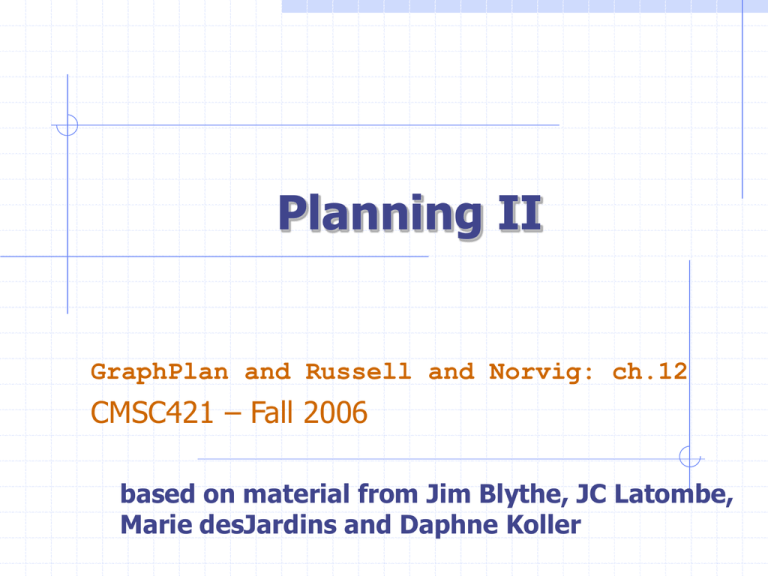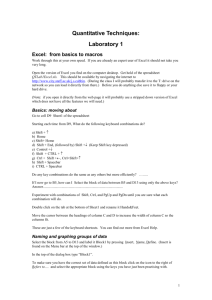Planning II
advertisement

Planning II GraphPlan and Russell and Norvig: ch.12 CMSC421 – Fall 2006 based on material from Jim Blythe, JC Latombe, Marie desJardins and Daphne Koller Real-world planning domains Real-world domains are complex and don’t satisfy the assumptions of STRIPS or partial-order planning methods Some of the characteristics we may need to deal with: Modeling and reasoning about resources Representing and reasoning about time Planning at different levels of abstractions Conditional outcomes of actions Uncertain outcomes of actions Exogenous events Incremental plan development Dynamic real-time replanning Planning vs. scheduling Planning: given one or more goal, generate a sequence of actions to achieve the goal(s) Scheduling: given a set of actions and constraints, allocate resources and assign times to the actions so that no constraints are violated Traditionally, planning is done with specialized logical reasoning methods Traditionally, scheduling is done with constraint satisfaction, linear programming, or OR methods However, planning and scheduling are closely interrelated and can’t always be separated Hierarchical decomposition Hierarchical decomposition, or hierarchical task network (HTN) planning, uses abstract operators to incrementally decompose a planning problem from a high-level goal statement to a primitive plan network Primitive operators represent actions that are executable, and can appear in the final plan Non-primitive operators represent goals (equivalently, abstract actions) that require further decomposition (or operationalization) to be executed There is no “right” set of primitive actions: One agent’s goals are another agent’s actions! HTN operator: Example OPERATOR decompose PURPOSE: Construction CONSTRAINTS: Length (Frame) <= Length (Foundation), Strength (Foundation) > Wt(Frame) + Wt(Roof) + Wt(Walls) + Wt(Interior) + Wt(Contents) PLOT: Build (Foundation) Build (Frame) PARALLEL Build (Roof) Build (Walls) END PARALLEL Build (Interior) HTN planning: example Increasing expressivity Conditional effects Instead of having different operators for different conditions, use a single operator with conditional effects Move (block1, from, to) and MoveToTable (block1, from) collapse into one Move (block1, from, to): Op(ACTION: Move(block1, from, to), PRECOND: On (block1, from) ^ Clear (block1) ^ Clear (to) EFFECT: On (block1, to) ^ Clear (from) ^ ~On(block1, from) ^ ~Clear(to) when to<>Table Negated and disjunctive goals Universally quantified preconditions and effects Reasoning about resources Introduce numeric variables that can be used as measures These variables represent resource quantities, and change over the course of the plan Certain actions may produce (increase the quantity of) resources Other actions may consume (decrease the quantity of) resources More generally, may want different types of resources Continuous vs. discrete Sharable vs. nonsharable Reusable vs. consumable vs. self-replenishing Applications of Planning Military operations Construction Most appliedtasks systems use extended Machining tasks languages, nonlinear representation planning techniques, Mechanical assemblyand domain-specific heuristics Design of experiments in genetics Command sequences for satellite Summary: Practical Planning More expressive representations Hierarchical Planning Exploit Abstractions Mix of scheduling and Planning



